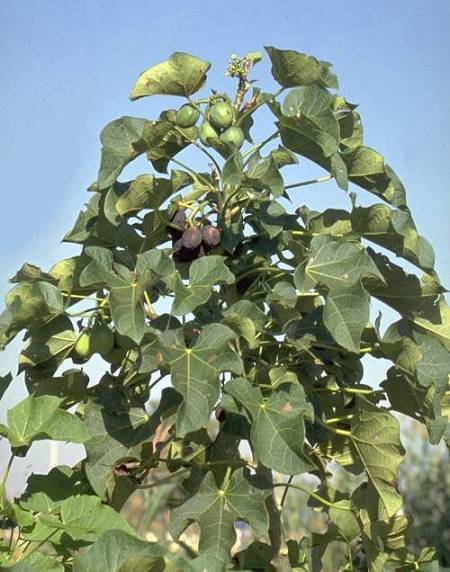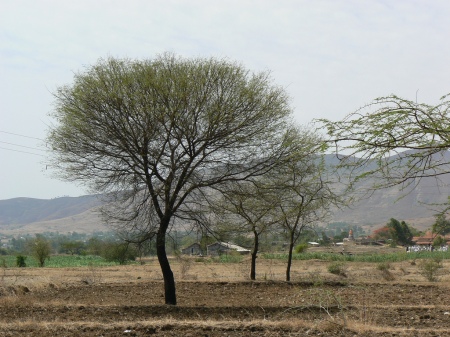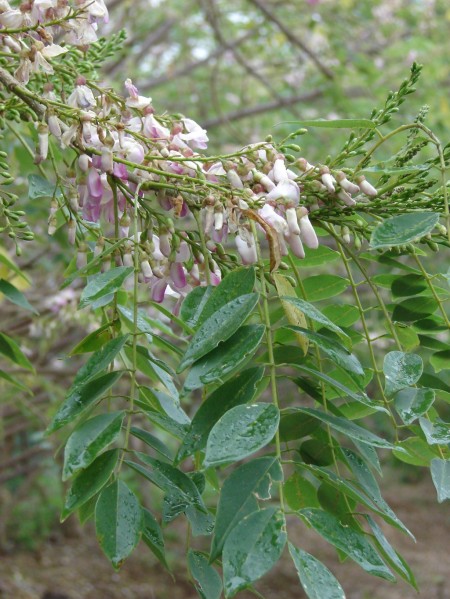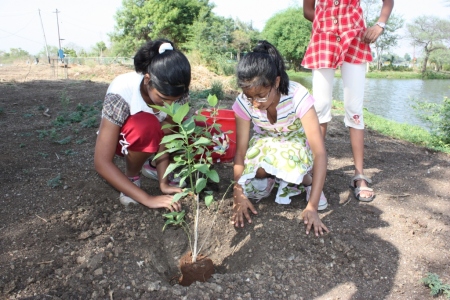Crafting India’s Landscapes!
(An extreme view of tree plantation & a small example of practice)
Its that time of the year when civic and nature organisations in India wake up from their slumber and begin to consider tree-planting yet again. Though this is an annual affair, strangely India’s forest cover and biomass doesn’t seem to improve even where these activities are being carried out.
Typically, tree plantation begins with the collection of whatever dismal fare in saplings the forest department is willing to provide, followed by the desultory digging of holes and careless planting of trees. This activity, concluded in a couple of days in the early monsoon, will be followed by a relapse into torpor. The final act is, of course, the appearance of a plague of self-publicised reports in the papers.

School-children plant trees as they take part in a "One day - One lakh plantation programme" on the outskirts of Hyderabad. Is this the way we should plant trees? (Click image to read more)
Over the next few months though, the thousands of saplings, thoughtlessly planted, are exposed to the harsh Indian environment accompanied by the complete neglect by the tree-planters. The subsequent perishing of the year’s plantation by the end of the next summer (except for the miniscule few which by God’s grace actually manage to survive) should come as no surprise. And in the hallowed traditions of Hindu religious ideology, the kaal-chakra turns to bring us back to tree-planting season again. Paradoxically, all of us feel good having participated in a worthwhile activity even though it is conducted so abominably.
Not all tree-planting is conducted this way. People plant carefully selected saplings to enhance their gardens and backyards. Some corporates do succeed in giving strikingly good tree-scapes and gardens to their campuses. Children all over carry out this activity with the single-minded intensity of play. To them it is something well worth doing. A few civic organisations do exceptionally fine jobs of restoring plant cover and biodiversity to their favourite haunts. But these are a drop in the ocean when compared to the morass of carelessly contrived tree-plantation schemes in our country. Not convinced by my assertion? Please see the text box below :
Unhealthy trends in tree plantation
- This tender gives no guidance whatsoever on the type of flora to be planted.
- Countries compete and are ranked.
- Pakistan feels good because it has “beaten” India. Heights of patriotism, won’t you agree?
I am sure you would have your own “war stories” to tell.
Its not that we are cultural “philistines” as far as trees and plants are concerned.
Hindu culture gives trees (or plants) an importance of their own. Planting a tree is said to be more fruitful than having a hundred sons. A number of trees figure in our pantheon of objects worthy of worship – the Peepul Tree (Ficus religiosa) and Banyan (Ficus benghalensis) come immediately to mind. The Kalpavrisksh which fulfils the wishes of all, the Bo tree under which the Buddha gained enlightenment, the Aak (Calotropis spp) tree under which Emperor Akbar was born are some examples of trees in our culture. Fragrant flowers are offered to our Gods in obeisance. Certain plants are associated with our deities – the “krishna” and “laxmi” varieties of Tulasi (Ocimum sanctum) and the Lord Dattatreya’s fondness for the Umbar or Audumbar (Ficus racemosa) spring to mind.

Kalpataru, the divine tree of life. The wish-fulfilling bountiful tree is guarded by mythical creatures Kinnara and Kinnar. This bas-relief is the adorned wall of Pawon temple, an 8th century small shrine between Borobudur and Mendut temple, Java, Indonesia.
Above image by Gunkarta. Source : Wikipedia.
Yet, we tend to approach tree-plantation with less finesse than a three year old child.
Perhaps it is semantics. The term “tree plantation” implies that our job is just to plant – it’s nature’s business to do the rest. The truth is, if we want to really make a difference, the business we should be in is “growing trees” not “planting trees”. That implies a whole lot more than partial burial of an juvenile plant in unprepared ground. The successful planting and growing of trees is not a rapid paced activity but takes an enormous amount of time and effort. Accordingly, there is a need for thinking deliberately, planning and careful preparation before we get down to the plantation which is just one event in the long process of growing trees.
Maybe the reason is selfishness. In this materialistic world, there is nothing to be gained by labouring for unborn generations. In such a view point, tree plantation would be meritorious only as a means for acclaim (for publicity and public adulation), getting rich (through corruption or by marketing one’s products) or as an indicator of performance (X planted more trees in his tenure than Y).

"Monocultures are ecological deserts. Tree plantations are not forests." (click image to learn more).
Another malaise in tree-plantation is mono-culture. It could be that most people do not realise that the planting trees of a single species, termed as mono-culture, is harmful. But the gaurdians of Indian forests should know. Invasive trees take away more from our environment than their successful propagation. Yet it is the bureaucratic forces which have championed the cause of ecologically harmful exotic trees which grow quickly – such as Australian Acacia (Acacia auriculiformis), Kubabul (Leucaena leucocephala) or the various forms of Eucalyptus – or even worse, the highly poisonous Jatropha curcas, purportedly for “bio-diesel”.

Jatropha curcas, the Physic Nut tree, is a poisonous, semi-evergreen shrub or small tree. Useful for biodiesel, it is ecologically useless. (Image: R.K.Henning, http://www.jatropha.org, CC-BY-SA 2.5)
It is the banal attitude towards tree plantation which reduces such a worthy activity to a pedestrian one that irks me greatly.

The highest form of appreciating nature is in growing exotic trees - Alexander von Humboldt. (Public domain image)
A great scientist of the nineteenth century, Alexander von Humboldt stated that the highest form of nature worship was engaging in one or all of the following :
- Writing Nature poetry.
- Painting landscapes.
- The rearing and planting of exotic trees.
I find that I agree broadly with Humboldt. This blog showcases some of the finest nature poetry. You can read about Frederic Edwin Church and his “Heart of the Andes” over here. I agree that growing of plants is a really worthy activity but I would replace the word “exotic” with the adjective “right”.
As far as growing trees is concerned, my own humble opinion can be summed up as :
Tree-planting is a craft. We should be “tree-smiths” – carefully crafting the environment in the manner that we make a Japanese garden, with each tree carefully chosen for effect, harmony, utility, importance, i.e. for a purpose. Growing trees is not meant to be hedonistic or banal. It must be done spiritually – a kind of zen activity. It must be done to completeness. And the result must be healthy trees that give us the benefits we hoped for and more.
For that, we really need to know and love our trees. I love to recall the feel of the bark and leaves of the Banyan, the smell of flowers of the Neem (Azadiractha indica) or the crushed leaves of the Kadi Patta (Murraya koenigii) , the visual extravaganza that the Laburnum (Cassia fistula) provides in summer. Once we get a feeling of love and appreciation of trees, then and then alone can we make quality choices about the best or most appropriate shrub or tree to be chosen for a spot.

Umbar or Audumbar (Ficus racemosa) - one of the trees best suited for biodiversity. (Image : Dinesh Valke, CC-by-NC-ND)
If you want to attract birds, the Umber or wild fig (Ficus racemosa) is your best bet. If you want a red avenue in summer, it’s the exotic Gulmohar (Delonix regia) you need to choose. For lots of shade with few trees, opt for the Rain tree (Albizia saman). You can never go wrong by planting Babul (Acacia nilotica) for the welfare of the poorest of the poor – it’s firewood has the highest calorific value.

Babul has the highest calorific value of Indian trees and is consequently of great importance to the common man. (Image credit : Dinesh Valke, under CC-BY-NC-ND)
On the other hand, if you don’t do the learning yourself and rely on the “experts”, expect to find that you have created yet another tree-covered barren landscapes by using Kubabul provided by the Forest Department or orchards of stunted Jatropha if you believe the agro-industrialists.
The real challenge in growing trees is not planting trees but keeping them alive. We can tackle this is many ways.
One is commitment. Choose carefully based on what level of care you can commit. In other words,
“Bite off only what you can chew”
or
“Cut your coat to suit your cloth”.
Our children of the Painted Storks Nature Club wanted to plant trees in the Sarvatra Bird Sanctuary. But it is not possible (or realistic to expect) for the children to come and water the plants since the sanctuary extends over many acres, has lonely corners, and very little access to water. So we decided to plant in close vicinity of the Middle Lake Garden which is frequented by the children, where water is nearby and where the gardeners can help water these plants.
The Lake Garden provided little scope for useful addition, so we decided to plant some trees and bushes around the CME Lake Mandir where except for a Tulsi plant (Ocimum sanctum var krishna) in front and a Tamarind tree (Tamarindus indica) above the temple, no other plants were present. It is just 30 meters from the garden and on the lakeshore itself.
We chose our plants carefully. Since we were planting around the mandir (temple), the emphasis was given to shrubs with bright flowers or having perfumed flowers. We tried to choose those which are commonly used for worship in Maharashtra. We also decided to plant three small-statured trees which would highlight the mandir’s background. We chose well-developed saplings for plantation which were sturdy enough to survive (unintentional) neglect and which already had some flowers so as to enthuse the children and give them a foretaste of how the garden would look. It was more expensive but worth it.
The Painted Storks planted the following shrubs on the side of the temple :
* “Juhi” (Jasminum auriculatum)
* “Mogra” or “Madanbaan” (Jasminum sambac)
* “Tagar” or Crepe Jasmine (Tabernaemontana coronaria)
* “Anant” (Gardenia jasminoides)
* Red Hibiscus (Hibiscus rosa-sinensis)
* “Raj Chameli” (Jasminum nitidum)
* “Chameli” (Jasminum flexile)
* “Zai” (Jasminum officinalis)
* “Sarpagandha” (Rauwolfia serpentina), a medicinal plant.
Behind the temple we planted three saplings of small trees having beautiful flowers :
* “Parijaat” (Nyctanthes arbor-tristis).
* “Savni” or Crepe Myrtle (Lagerstroemia indica).
* “Sonchafa” or “Champak” (Michelia champaca).
That is it – exactly twelve plants, but well chosen, well planted and well-located. What do you think are the odds of survival of these twelve than the desultory planting of many more? And when they do survive which will give the better effect?
One could of course say, don’t confuse gardening with tree-plantation, but the principles are the same.
Problems and dilemmas will arise in this activity, as it does in all of mankind’s ventures. The most important one would that as to how to water the plants regularly. In my opinion, this would be the most difficult of all tasks associated with nurturing trees. When we know that we cannot come often to water the plants, should we not plant?
We could choose to plant drought resistant native species such as Neem and Babul. We could jury-rig drip irrigation with plastic bottles and tubes which would need less water and give a longer effect. We could mulch the saplings – the mulch helps retain the water, reduces erosion, suppresses weed growth and seed germination and adds to the fertility over time. We could water in the evening where our water loss due to evaporation will reduce. We could choose to come at a fixed intervals as per our convenience – say once a fortnight or month, to water the plants accepting the triage due to the environment. We could plant hardy two-three year old saplings rather than very small saplings.
By applying our mind, and by matching our effort to our thought, we can increase the chances of survival of the trees.
If I were to plant a few hectares of arid area in Maharashtra, for example, I would choose native species such as Babul and Ber (Zizyphus jujuba) for the general backdrop, add a few Ficus to form the focal points and plant many interesting but scarce trees. A few Agaves would help prevent soil erosion in the monsoon run off along with some simple landscaping, a few legumes would help improve the soil condition. There would also be a few creepers, many shrubs (both perennial and annual) and definitely useful grasses and bamboo. Maybe a few exotic Gliricidia trees to provide ready-made green manure for the caretakers. Amidst these, a few trees or shrubs carefully selected to provide all kinds of resources (nectar, food, shelter, nesting etc) to the typical biodiversity of that place.

Mother of Cacao (Glyricida sepium) a green manure tree. (Image :Kim & Forest Starr, CC-BY-SA 3.0, click image for source.)
That’s all I can come up with off the cuff. But in reality, the tree plantation scheme for this otherwise hypothetical scheme would be worked out carefully in much greater detail and perhaps even plotted graphically on a map. The location, aim, species available would all be considered. A planting schedule over two-three years would be considered. The civil engineering works would be restricted to a bare minimum. Nothing more than a fence, water tank or supply. A shed for the forest guard and perhaps minimal amenities in a place under a shade tree where the nature-lovers can sit, rest, enjoy nature, have their meal etc.
However, I would expect the record-keeping and science to be top class. None of the careless generalities thrown in by so-called experts. The practice of science in even such a routine activity as tree-plantation should be second to none.
That then is my view of tree-planting…
Let’s not just plant trees, let’s craft Nature.
Credits:
My sincere thanks to Mr Nandan Kalbag of www.gardentia.net who dotes on his son-in-law (yours truly) and fielded telephone calls on asking what plants to choose at all times of the day and night.
Members of Indian Tree Pix/EFlora India such as Mr JM Garg & Mr Dinesh Valke (and others) who made images available on the internet with Creative Commons licenses.
Century Post & World Biodiversity Day tomorrow
This post is the 100th on this blog. Tomorrow is World Biodiversity Day. I hope that I have done justice to these landmarks with this post/
Explore posts in the same categories: Alexander von Humboldt, flowers, gardens, lakes, landscape painting, Nandan Kalbag, nature, plants, scented plants, trees, wetlandsTags: CME, Painted Storks Nature Club, tree plantation
You can comment below, or link to this permanent URL from your own site.








21 May 2010 at 7:31 am
Two of the easy to plant trees-Papaya and Drumstick – do not seem to get the importance they deserve in tree plantation drives. Both do not need special care and yield very useful fruits.
21 May 2010 at 7:49 am
You are absolutely right. These trees are imminently suitable for Indian backyards and yield useful fruits.
In fact, there is such a wide variety of trees available of all kinds whether we speak of avenue trees, or forest trees, fruit trees, trees good for biodiversity or ornamentals – that the mind boggles.
Hence my thesis – we need to know this vast assemblage so that we can make “right” decisions about planting trees.
21 May 2010 at 11:25 am
Thanks Roshmi, that link is a really valuable addition. I’d love that people plant creepers, bushes & trees. Planting flora is a great way to enhance the serenity and beauty of our religious institutions.
21 May 2010 at 11:14 am
That was a wonderful post indeed… and so enlightening… as always! Congrats on your century!
Programs such as “One day – One lakh plantation programme” are designed to ‘enrich’ certain individuals. And hence “experts” will continue to be consulted.
Looking at the pic of the Parijaat flower/Shiuli phool… I went down nostalgia lane. This plant and its beautiful flowers are found widely in Bengal… especially during Durga puja.
I wasn’t aware that it is called ‘Parijaat’ though… Thanks for the info 🙂
Haven’t seen this plant in Bangalore yet. Will renew my search and if I find one… will plant it in the compound of a nearby temple. Incidentally, we are clearing the garden of this temple (which is in a very sad state) and planting new trees and plants. I’m amazed at the attitude of the people here… nobody is bothered really!
P.S. Here is the link to a booklet “ON THE MYTHOLOGY OF INDIAN PLANTS”. I thought it will add to this post:
Click to access manekatrees.pdf
22 May 2010 at 2:37 am
Chandigarh has a fairly decent green cover, being a planned city. Yet the summers are getting more and more fierce because it is not enough.
I love having plants and trees and shrubs around.
Congratulations on the 100th post.
Congratulations to the Painted Stork Nature Club for their efforts.
Here is a song about beautiful flowers that I absolutely love.
22 May 2010 at 4:19 am
Chandigarh being a planned urban area has a great layout. Unfortunately I have never paid attention to the trees while passing through it. I’m sure that this aspect must have been planned too. I’ll keep an eye out for material on this aspect.
Thank you for this link to this lovely Indian Classical music song from “Basant Bahar”. It is a honourable way to introduce this venerable facet of our culture to “The Butterfly Diaries” with Pt Bhimsen Joshi & Manna Dey in jugalbandhi.
I would encourage non-Indian visitors to give a try-out by listening to this song, one of the great songs of Hindustani classical music (the correct term for the genre).
22 May 2010 at 7:16 am
Congratz on hitting the century !!! Now looking forward to a double century 🙂
Reading the post was very informative and really liked the word “Tree-smiths” … As rightly pointed by you planting tree initiatives by large have become a publicity stunt for a day. Recently near by my home, they planted around 300 trees in the ring road. Within 2 months what is left now is dried sticks except for 2-3 gritty survivors. First of all am sure they did not do a proper planting, second there was no follow up on the saplings till they support themselves. Ofcourse this drama of planting will start again when the mansoon starts…
And I always wonder what tree suits best for city roads? With constant road works bane of indian cities – a tree with a vertically straight root should be a wiser choice than a horizontally spreading roots right? What choices we have in that kind for city roads?
24 May 2010 at 1:49 pm
Hi Lakshmi,
Sorry for the delayed response. Went crazy trying to relocate my copy of M.S. Randhawa’s Flowering trees. Couldn’t find it. So here goes.
Don’t know too much about it, so I asked my father-in-law Mr Nandan Kalbag of gardentia,net. He recommends the following trees based on your requirement of straight root and reduced sideward spread :
* Markhamia lutea – Markhamia, Siali
* Cassia fistula – Amaltas , Indian Laburnum
* Mimusops elengi – Bakul
* Cassia spectabilis
* Lagerstroemia flos-reginae – Queen’s Flower
* Lagerstroemia speciosa – Crepe myrtle
23 May 2010 at 11:15 am
Thank you for this very interesting and informative piece.
As we all know, many thousands of roadside trees planted during British times have been hacked during road-widening which is necessary to cope with increasing traffic. Unfortunately none of the contracting companies seem to feel it necessary to replace these.
27 May 2010 at 11:42 am
We certainly understand your sentiments regarding tree plantation drives that only end up in barren lands within a year. In fact it is great that we came across this post. We know what not to do. We are a 5 star Eco-friendly hotel located in Jaipur, Rajasthan. We have our own tree plantation campaign coming up called Plant A Million. Do follow us on Twitter @fernecotel and join us on Facebook as well! We aim to do things right!
http://www.facebook.com/fernhotels?ref=ts#!/fernhotels?ref=ts
http://twitter.com/FernEcotel